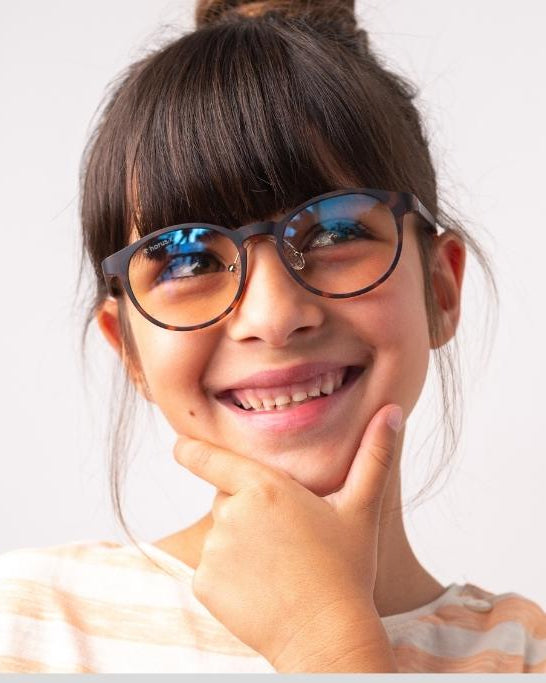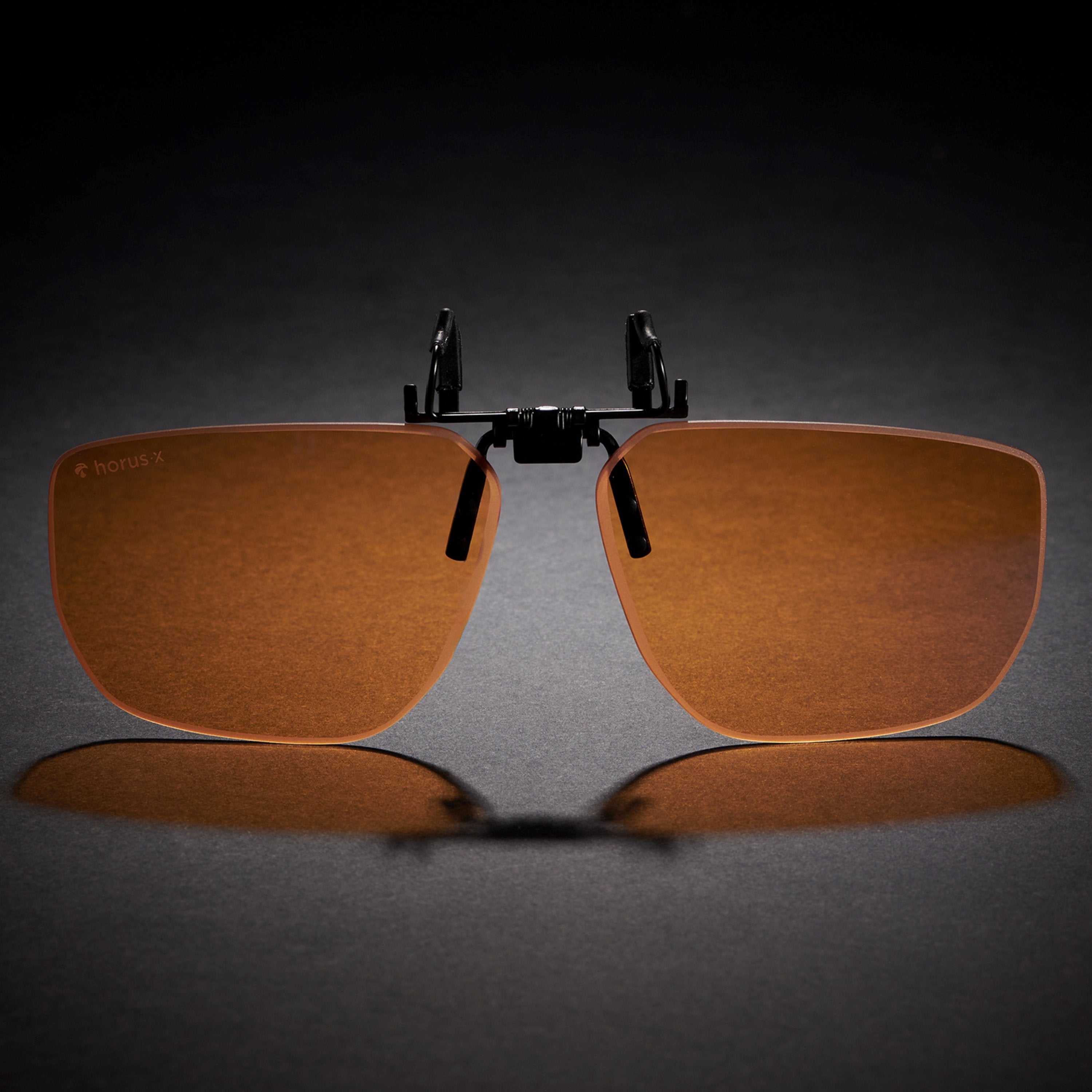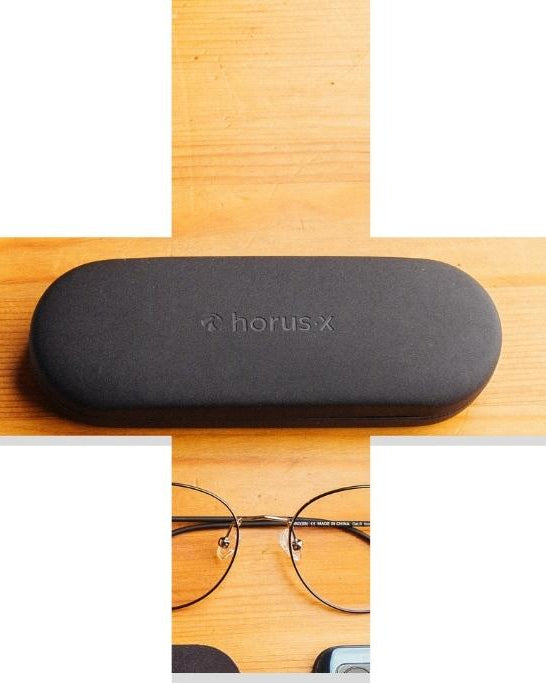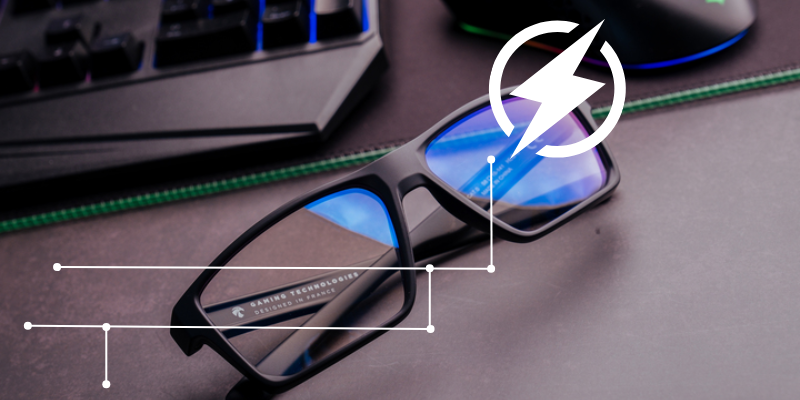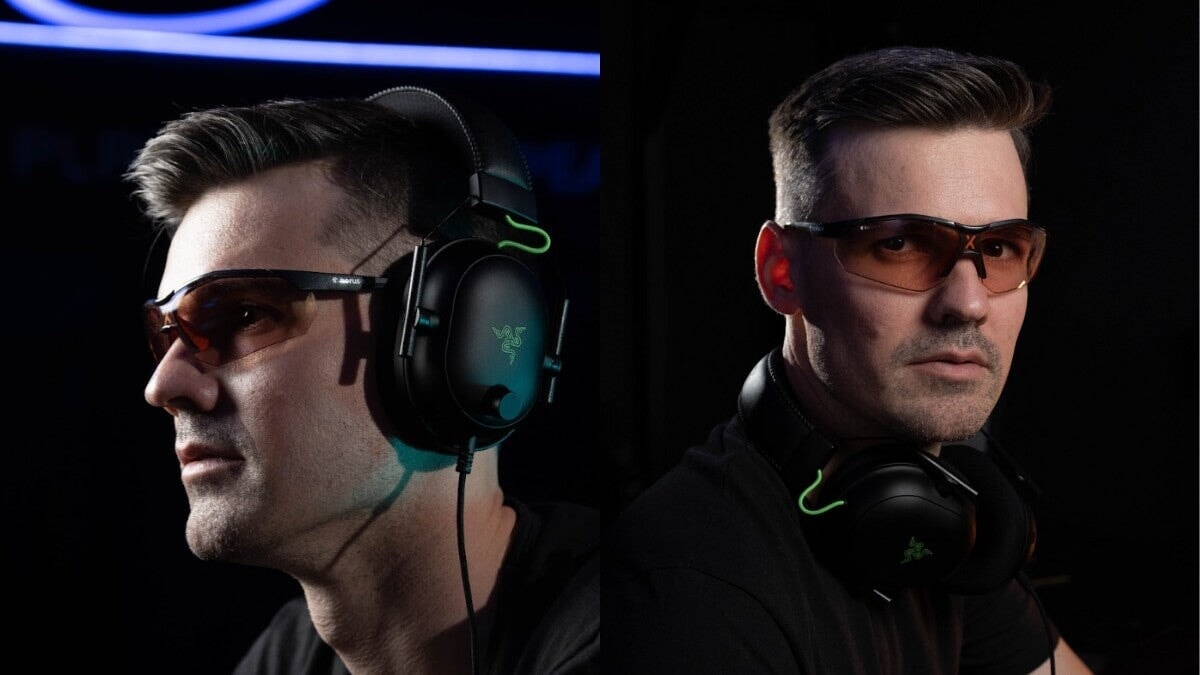How do you choose a good pair of blue light eyewear goggles when you still can't decide between Bulbasaur, Charmander and Squirtle?

It’s hard to choose, especially when you’re not 100% sure what you should be looking for, or taking into consideration.
But protecting your eyes is essential! Whether you’re a gamer, a computer scientist, an office worker or just someone who spends a lot of time watching TV, you need blue light eyewear to reduce strain, blurred vision and fatigue.
What Is Blue Light?
Blue light is one of the most intense parts of the visible light spectrum, with very short wavelengths that produce a large amount of energy.
This high-energy light sits between wavelengths of 380 and 500 nanometers (nm), but not all of it is necessarily harmful to our eyes and body!
Blue light is composed of:
- “Ultra-harmful” blue-violet light (380–400 nm) and more broadly the “harmful” range (380–450 nm), which contribute to retinal aging and should be filtered out as much as possible.
- Beneficial blue-turquoise light (450–500 nm). This range is essential for regulating our biological rhythms (well-being, sleep, etc.). The goal is therefore to filter out as little of this portion of blue light as possible.
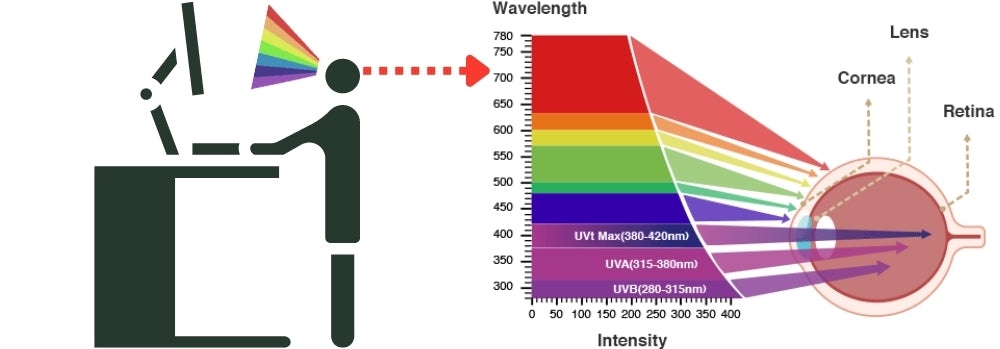
You can read more about blue light and check out our blue light guide with scientific references and resources.
Long before humans became one with their screens, blue light naturally came from the sun. But since technology has taken over our daily lives, we’re now exposed to another source of blue light: artificial light from LED or fluorescent bulbs, LCD and LED screens, and more.
Blue light is present in every device with a lit screen: smartphones, tablets, computers, e-readers, gaming consoles.
Whether you’re enjoying a good round of Mario Kart or reading the latest Stephen King on your tablet, you’re probably soaking up a hefty dose of blue light from your screen.
The Harmful Effects of Blue Light Exposure

Dut to its high energy level, blue light passes through the cornea and lens and slowly damages the back of the retina and the macula of our eye. This results in progressive oxidation and accelerated macular degeneration. In other words, it can wreak as much havoc as a horde of orcs at Helm’s Deep.
Many eye health issues have been linked to increased blue light exposure, both short- and long-term. This intense brightness affects not only our pupils but also our overall health.
Short-Term Effects
Scientists have shown that increased blue light exposure can cause several short-term vision issues:
- Digital eye strain
- Dry eyes
- Itchy eyes
- Fatigue
- Sore eyes
- Headaches

Long-Term Effects

Although there are more and more clinical studies, there is still no general consensus among the scientific community on the exact long-term impact of blue light exposure to our eyes.
However, some experts agree:
- Without protection, prolonged blue light exposure could damage the retina and speed up macular degeneration, the leading cause of vision loss. This condition affects color perception, reading, writing, driving, and other cognitive functions, and can eventually lead to blindness.
- Our body regulates its day/night cycle based on sunlight’s blue light. Excess exposure to artificial screen light may disrupt melatonin production, which affects our sleep/wake cycle.
Melatonin is the hormone that regulates sleep and wakefulness. Recent research even suggests a possible link between low melatonin levels and conditions such as sleep disorders, as well as risks of clinical depression, obesity, organ dysfunction, and weakened immune function. Better safe than sorry!
For all these reasons, we recommend wearing blue light eyewear, limiting your screen time, and stopping screen use at least one hour before bed.
Blue Light Eyewear: Why and How to Choose Them?

Blue light eyewear are like items you equip your character with to boost their stats and make them stronger against the enemy. In this case, the glasses are specially designed to protect your eyes from the big boss, Blue Light.
These glasses provide varied levels of blue light protection. This way, you save your eyes from internal damage caused by blue wavelengths and avoid short-term side effects from screen exposure.
However, choosing the right pair isn’t always easy. There are several factors to take into account.
Choose Your Lenses Based on Your Needs

Firstly, why do you want blue light eyewear?
For gaming? To rest your eyes? For work? For your kid? For your cat who spends way too much time on TikTok?
What you want glasses for will determine what type of frames and level of protection you need.
🤓 Need prescription lenses? We hear you, nearsighted friends in the back! No need to rush to the optician for blue light prescription glasses with a “meh” filter — we’ve created prescription blue light glasses that truly protect your eyes from artificial screen light.
Choosing the lens filtration rate

Make sure you have right filtration rate:
According to studies from INSERM, the most harmful light waves for our sight are between 380 and 450 nm with particularly intense rays between 415 and 455 nm (with the peak at 430 nm).
Make sure to choose blue light eyewear that filters the right wavelengths of blue light.
For example: Blue light blocking glassses that only filter from 400 to 430 nm, must block over 90% of rays, to be really effective. For larger wavelengths between 380 and 450 nm, the filtration rate must be at least 60%. (Horus X glasses filter up to 86% of the wider spectrum)
Lens color
The color of the lenses is also important: Blue light blocking glasses typically offer clear lenses or amber lenses.
Amber lenses (or yellow lenses) provide an increased level of protection, designed for gamers and heavy screen users who experience greater exposure to blue light.
Clear lenses are more appropriate for those who work on screens in the day but don’t have as heavy screen lives outside of work. Office workers and other professionals should wear clear lenses during the day to keep their eyes sharp.
💡 Pro tip: if you want top-tier lenses, check that they also have anti-reflective coating. Naturally, ours feature anti-reflective treatment for ultimate visual comfort.
Go for Quality Materials

What would Tony Stark be without his titanium-and-gold armor?
The materials used for your glasses are as important as the blue light eyewear itself. Because they impact both durability and your comfort.
Frame Weight
When choosing blue light blocking glasses, you must check the weight of the model . Lightweight glasses are great for several reasons: they won't leave marks on the top of your nose, they'll cause less aches and pains tire you less, and they'll be more comfortable to wear.
Durability
You need blue light eyewear that is made from good, strong, durable materials. We recommend:
- Elastomer (a type of unbreakable rubber) — perfect for kids
- Polyamide (strong and lightweight, often used in sports eyewear)
- Stainless steel (light and sturdy, though not the most stylish)
- Polycarbonate (resistant, flexible, lightweight — our favorite)
- Cellulose acetate (a plant-based plastic — eco-friendly, flexible, and highly durable — the perfect combo)
Pick the Right Size
Blue light eyewear comes in different sizes. Some websites even list them like clothing sizes: S, M, and L.
These sizes correspond to the distance between the lower hinges.
- Size S is about 120 mm
- M ranges between 120–130 mm
- L is over 130 mm
Getting the right size is key to ultimate comfort. Some brands also offer one-size-fits-all models, carefully designed to suit all face shapes.
Ideally, you should know which glasses fit your face shape best. Some websites even offer virtual try-on tools so you can preview the fit in 3D.
Of course, nothing beats trying them on in real life. Some (rare) brands even offer a satisfaction guarantee or free exchange policy, so you can test your pair risk-free.
Pay Attention to Design
Since your glasses sit right in the middle of your face, you’ve got to like how they look — obviously!
The design should balance aesthetics and functionality, expressing your personality while fitting your face shape perfectly.
It should also suit your usage — for instance, make sure the frame works well if you wear headphones.
Don’t Forget the Accessories

When buying a new pair, nothing beats getting a few extra goodies: a carrying case, a cleaning cloth, cords or chains, a cleaning spray...
Always check what’s included — those small touches really make a difference.
Check the Warranties
Nothing says security like a lifetime warranty. Check to see what type of warranty and refund guarantee the company you purchase your blue light eyewear from offers. Like Horus X for example, who offer a lifetime guarantee.
Essential: Make Sure Standards Are Met
Blue light lenses are the result of years of research in optics, and it may seem obvious that a product must meet certain standards but this is not always the case.
Before choosing, always make sure that the model complies with the standards.
In Europe, they should pass theCE / EN ISO standard 12312 -1 2013 .
In the US they need to adhere to ANSI standards.
Consider the Company’s Values
Buying a pair of blue light blocking glasses also means trusting a company, for the quality of its products, but also through the values it espouses through its messaging and initiatives.
Some companies actively support humanitarian organizations and contribute to charitable initiatives, demonstrating their commitment to a fairer world.
This is the philosophy behind 1% For The Planet, a global environmental movement that Horus X proudly participates in.

The goal of this movement is to support and unite a network of companies financially committed to creating a healthier planet, helping non-profits better protect lands, forests, rivers, and oceans, and promoting sustainable energy production methods.
It’s very important to learn about companies that are actively involved, so your purchase can contribute to a fair, human, and impactful cause.
Final Word: How to Choose the Right Blue Light Eyewear
Choosing glasses is a lot like an RPG quest. You need to pay attention to many details.
The best blue light eyewear combines an excellent filtering rate for harmful blue light (with our patented tech), lenses suited to your usage, a lightweight, comfortable, and durable frame, compliance with standards, and solid warranty coverage. And we know exactly where to get them, with the added bonus of an unbeatable value for money: Horus X, of course!
We’ve spent years (and continue to do so) developing different frames, all equipped with our patented technologies, to effectively protect your precious eyes from harmful screen rays.
To see for yourself, check out our Nomad Blue Light Collection for everyday use, and our Gaming Collection for beginner or pro gamers, without compromising quality. Of course, we also cater to younger eyes with the Kids Blue Light Collection.




